What is a Demand-Side Platform (DSP): A Comprehensive Guide for Publishers
Demand side platforms (DSPs) provide a centralized interface where real-time bidding and algorithms automate the buying and selling of ad inventory. DSPs also provide access to premium inventory and exclusive deals, giving advertisers a competitive edge in reaching high-value audiences.
To put it simply, DSPs ensure precise targeting and efficient media buying.
In this article we’ll explain what DSPs are and how they operate, and why they are so significant in the programmatic advertising landscape. Let’s dive in!
What is a DSP?
A DSP is a programmatic advertising platform that allows advertisers and agencies to buy ad inventory from multiple ad exchanges using real-time bidding (RTB) technology. DSPs provide a centralized interface where marketers can manage digital ads across various networks, including mobile apps, search engines, and social media platforms.
How DSPs Fit into Programmatic Advertising?
DSPs are an integral part of programmatic advertising. The primary advantage of using a DSP is its efficiency in ad buying–it enables purchases from multiple sources in one place, making the process faster, cheaper, and more streamlined.
DSPs represent the demand side in programmatic advertising, working for advertisers and agencies to purchase the best available ad spaces based on specified criteria such as audience targeting, budget, and campaign goals.
They interact with supply-side platforms (SSPs), representing publishers looking to sell their digital ad space. This interaction occurs within ad exchanges.
DSP vs SSP vs Ad Network: Key Differences Explained
Understanding the differences between DSPs, SSPs, and ad networks is essential for navigating the digital advertising ecosystem. Each plays a distinct role in connecting advertisers with publishers, streamlining the buying and selling of ad inventory, and optimizing campaign performance.
Demand-Side Platforms (DSPs): Tools for Advertisers
DSPs, or demand-side platforms, are designed for advertisers and agencies. They provide a centralized platform to purchase ad inventory across multiple channels, such as websites, apps, and connected TV. DSPs use real-time bidding (RTB) to allow advertisers to bid on impressions programmatically, ensuring precise targeting and cost efficiency. Key features include:
- Advanced targeting: Leverage data for audience segmentation based on demographics, behavior, and intent.
- Real-time optimization: Automatically adjust bids to maximize ROI.
- Cross-platform buying: Access to ad inventory across multiple SSPs and exchanges.
Additional reading: What is a self-serve DSP.
Supply-Side Platforms (SSPs): Tools for Publishers
SSPs, or supply-side platforms, are tailored for publishers to manage, sell, and optimize their available ad space. These platforms help publishers maximize revenue by offering inventory to multiple DSPs and ad exchanges in real-time. Key capabilities include:
- Inventory management: Organize and control available ad slots.
- Revenue optimization: Use algorithms to set competitive prices for ad impressions.
- Integration: Seamless connectivity with DSPs, ad networks, and ad exchanges.
Ad Networks: The Middlemen
Ad networks aggregate ad inventory from publishers and package it for sale to advertisers. They act as intermediaries, often focusing on a specific niche or market segment, such as mobile ads or video ads. While less automated than DSPs or SSPs, ad networks remain a straightforward option for advertisers and publishers. Key characteristics include:
- Pricing markup: Ad networks often sell inventory at a premium.
- Inventory curation: Aggregated supply from multiple publishers.
- Simplified buying: Advertisers purchase pre-packaged inventory without bidding.
| DSPs (demand side platforms) | SSPs (supply-side platforms) | Ad networks | |
| Purpose | Allows buyers to automate the purchasing of ad inventory | Allows publishers to automate the selling of ad space | Aggregates ad spaces from publishers and sells them to advertisers |
| Primary users | Advertisers and agencies | Publishers and media owners | Advertisers and publishers |
| Functionality | Uses real-time bidding to purchase ads | Manages ad inventories and maximizes publisher revenue | Sells inventory at marked-up prices, managing supply and demand |
| Automation | Highly automated with advanced targeting and bidding | Highly automated to optimize ad fills and pricing | Less automated, serves as a middleman |
| Technology | Real-time bidding and data integration | Integrates with DSPs and ad exchanges | May use some aspects of real-time bidding |
| Integration | Integrates with multiple SSPs and ad exchanges | Integrates with DSPs and ad networks | Typically integrates with SSPs and directly with publishers |
How Do DSPs Work?
DSPs connect to ad inventory supply sources that publishers make available, allowing advertisers to buy ad placements based on impressions across various sites and apps.
Modern DSPs offer cross-channel media buying, encompassing OTT, CTV, social media, and direct publishers, rather than solely connecting to ad exchanges and ad networks.
Additionally, contemporary DSPs can centralize campaigns from different channels into a single user interface, enabling media buyers to set up, optimize, and analyze campaigns across multiple channels within one platform.
Real-time bidding (RTB) in the context of DSPs
RTB is a highly efficient, automated process that determines which ads users will see when visiting a website or app.
- For example, when a user lands on a site, an SSP sends a bid request to an ad exchange indicating ad inventory availability, user data, and publisher requirements. This bid request initiates an auction among advertisers. DSPs then analyze the bid request in real-time, deciding whether to place a bid and determining the bid amount. The highest bidder wins the ad space, making premium ad placements particularly competitive.
Once the auction ends, the winning ad is instantly displayed to the user. This entire process, known as real-time bidding, is automated and occurs within milliseconds, ensuring users receive ads instantly.
The Technology Behind DSPs
Here’s a little explainer to understand all of the technological components that DSPs include:
Integrations
Supply sources. DSPs connect to Supply-Side Platforms (SSPs) and ad exchanges to access ad inventory. This integration allows DSPs to participate in real-time bidding (RTB) auctions.
Data management platforms (DMPs). DSPs often integrate with DMPs to enhance ad targeting by leveraging user data and audience segments.
Creative optimization platforms. These platforms help improve ad creatives’ performance by optimizing them for better engagement and relevance.
Bidders
Real-Time Bidding
Bidders play a crucial role in the programmatic advertising ecosystem by placing bids on ad inventory during real-time bidding (RTB) auctions. To ensure timely responses—typically under 200ms—DSPs deploy multiple bidders across various data centers, optimizing performance and minimizing latency.
Caching
To further enhance efficiency, bidders maintain cached versions of an advertiser’s campaign targeting criteria. This reduces latency and enables quicker responses to bid requests, ensuring seamless participation in RTB auctions.
Looking for a robust bidding solution? Setupad’s bidder offers advanced capabilities designed to maximize ad performance while minimizing latency, helping advertisers and publishers achieve their goals efficiently.
Ad server
Creative storage and delivery. The ad server stores ad creatives and their markup, displaying the ads to users. Some DSPs have their own ad servers, while others connect to external ad servers.
Campaign tracker
Performance data collection. The campaign tracker gathers data on campaign performance, such as impressions, clicks, and bid wins. This data is then forwarded to the reporting database for analysis.
Banker (budget manager)
Budget management. The banker ensures campaigns do not overspend. During RTB, the high volume of bids and potential delays in win notices from SSPs and ad exchanges can lead to overspending, which the banker helps to mitigate.
Databases
Data storage and reporting. The reporting database stores performance data collected by the campaign tracker and generates aggregated reports accessible through the user interface.
User data storage. This database holds user information, including ads viewed and segment memberships. It is crucial for functions like frequency capping (limiting the number of times a user sees an ad) and retargeting (serving ads to users who have previously interacted with the brand).
User interface
Campaign management. The user interface is the platform through which advertisers create and manage their campaigns. It allows them to set targeting parameters, choose ad placements, monitor performance, and manage budgets.
Types of user data used by DSPs for targeting and bidding
Demand-side platforms use multiple user data sources to optimize their targeting and bidding strategies. They collect their own data from ad impressions and clicks, including metrics such as ad spend, click-through rates (CTRs), and return on investment (ROI).
Advertisers often import user data from their customer relationship management (CRM) systems to create precise targets for remarketing campaigns and to build lookalike audiences based on detailed customer profiles.
Publishers also share valuable data about the context in which ad impressions occur and the users who trigger them. They offer demographic insights (such as location and device type) and behavioral information (like browsing and shopping history).
Additionally, DSPs can enhance their targeting capabilities by purchasing data from third-party platforms, which allows them to construct custom audience segments tailored to specific advertiser criteria.
Demand-Side Platform Types
Self-serve DSPs
Self-serve DSPs (e.g., Amazon DSP) empower advertisers to manage their ad-buying processes directly. Upon subscribing to the platform, users can upload their creative content, place bids on ad spaces across multiple exchanges, and fine-tune their campaigns according to their specific goals and budget constraints.
This type of DSP offers significant control over the advertising process and is cost-effective, as it eliminates the need for intermediaries, thus broadening the potential audience reach.
White-label DSPs
White-label DSPs (e.g., Targetoo) are customizable platforms companies can purchase and tailor to their specific needs, branding them as their own. Users of white-label DSPs can develop unique programmatic algorithms for ad placements and integrate them with an extensive network of ad exchanges and SSPs.
This allows for a highly personalized approach to ad buying, catering to specific marketing strategies and expanding audience targeting capabilities.
Full-service DSPs
Full-service DSPs (e.g., Adform) are ideal for companies that prefer not to manage their digital advertising campaigns directly. Similar to working with an advertising agency, this DSP type provides clients with a dedicated account manager and team that handles all aspects of the campaign, from planning to execution.
Opting for a full-service DSP means sacrificing some degree of control for convenience. Still, it includes the benefit of expert management, which can be particularly valuable for organizations lacking in-house advertising expertise.
However, advertisers must commit to a minimum budget for every campaign. Since full-service DSPs can be expensive, large organizations opt for this option, which lets them outsource the responsibility and work to an external team.
Specialized DSPs
Specialized DSPs cater to specific types of digital advertising, optimizing the buying process for various formats and devices. Here are some examples and how they work:
Mobile DSPs
Mobile DSPs focus on serving ads on mobile sites and apps. They ensure ad creatives are properly formatted for different screen sizes, providing a seamless user experience. Programmatic mobile DSPs connect to various ad exchanges, SSPs, websites, and mobile apps, providing access to a broad range of mobile traffic sources.
Note: Mobile DSPs typically support advertising across both mobile and desktop platforms, allowing advertisers to reach users on multiple devices.
Video DPSs
Video DSPs specialize in managing video ad campaigns across real-time bidding on ad exchanges. These DSPs support various video ad formats, such as in-stream, out-stream, and rewarded videos, catering to diverse advertising needs.
Video DSPs help advertisers create engaging content that captures the audience’s attention, driving higher engagement rates.
CTV DPSs
CTV DSPs focus on placing ads within TV channels’ content streams rather than on static website banners. They are tailored to the unique requirements of advertising on connected TVs and streaming devices.
CTV DSPs insert ads into the streaming device content. These DSPs ensure that ads are delivered in high-definition formats suitable for large TV screens, maintaining visual quality. CTV DSPs leverage audience data to target ads based on viewing habits, demographics, and other criteria, enhancing the relevance and effectiveness of TV ads.
DSP Integration with Ad Exchanges
DSPs, SSPs, and ad exchanges collaboratively facilitate the buying and selling of ad impressions.
- Ad exchanges are the marketplace for buying and selling ad inventory, connecting DSPs and SSPs.
Publishers use SSPs, which “plug in” to ad exchanges, to make their inventory available for sale. This integration enables publishers to list their available ad space on the marketplace.
Advertisers use DSPs to connect to ad exchanges to access and evaluate the available ad impressions. DSPs analyze the ad inventory against the criteria set by advertisers, such as target audience, budget, and campaign goals.
By integrating with ad exchanges, DSPs can access a wide range of ad impressions, while SSPs help publishers optimize their revenue, creating a balanced and competitive marketplace for digital advertising.
Role of SSPs in DSP Dynamics
SSPs and DSPs have distinct but complementary roles.
- Publishers use SSPs to maximize revenue by selling ad inventory at the highest possible price. SSPs manage the supply of ad space and help publishers optimize their yield.
- DSPs are used by advertisers to purchase ad space cost-effectively. DSPs aim to minimize costs while ensuring the ad placements meet the advertiser’s targeting criteria and campaign objectives.
During the RTB process, SSPs and DSPs interact to balance pricing. The SSP considers the publisher’s floor price (the minimum price at which the ad space can be sold), while the DSP evaluates the advertiser’s bid price (the maximum price the advertiser is willing to pay).
The ad exchange facilitates the auction, where the highest bid that meets or exceeds the floor price wins the ad impression.
Benefits of Using a DSP for Publishers
Publishers can integrate with DSPs through SSPs and ad exchanges. By doing so, publishers gain access to a broader pool of potential advertisers, increasing competition for their ad space and driving up prices.
DSPs provide advanced targeting and real-time bidding capabilities, ensuring that ad impressions are sold to the highest bidder who meets the publisher’s criteria. This not only enhances the efficiency of the ad selling process but also improves yield management, allowing publishers to monetize their inventory better.
Benefits of Using a DSP for Advertisers
Advertisers can have many benefits from using a DSP, such as:
- Targeted audience reach: DSPs provide access to a vast inventory of ad spaces across various websites and platforms, ensuring precise audience targeting.
- Diverse ad formats and channels: Support for multiple ad formats and channels enhances campaign versatility and engagement.
- Real-time bidding: DSPs enable advertisers to place bids across multiple ad exchanges in real-time, optimizing ad spend and allowing adjustments based on immediate insights.
- Access to useful features: Features like creative content management and frequency capping are crucial for successful campaigns, and DSPs provide easy access to these tools.
- Unified campaign management: DSPs offer a centralized platform for managing campaign parameters, budgets, and targeting criteria, streamlining the optimization process.
- Data-driven decision-making: DSPs empower advertisers to leverage data analytics, track KPIs, analyze audience insights, and adjust real-time campaigns for optimal performance.
Choosing the Right DSP
When choosing the right DSP, evaluate how critical specific features are to your advertising needs. Identify essential criteria, such as geographical targeting and language support, and determine whether these are must-haves, nice-to-haves, or unnecessary.
Prioritize DSPs based on the value they bring to your company.
- For example, if extensive onboarding support is crucial, consider smaller DSPs like StackAdapt. Larger platforms like The Trade Desk may be more suitable if you’re looking for a DSP with a significant market share and numerous success stories.
Assess scalability, global reach, and support for future growth to ensure the DSP can accommodate your expanding needs. Effective DSPs should offer seamless automation, granular audience targeting, comprehensive insights, and robust measures for brand safety and fraud prevention.
Key Features to Look For
In a wrap-up, here are the 7 key features you should keep your eye on:
- Cost–determines the affordability and overall value of the platform, impacting ROI.
- Support–essential for troubleshooting and maximizing the effectiveness of ad campaigns.
- Reach–the breadth of the audience the DSP can target, affecting the campaign’s potential impact.
- Integration and compatibility–ensures seamless connection with other adtech tools and platforms, enhancing operational efficiency.
- Ad formats and creatives–the ability to support diverse ad types, enabling more engaging and versatile campaigns.
- Insights and reporting–provides detailed analytics for tracking performance and optimizing strategies.
- Fraud prevention and brand safety–protects against ad fraud and ensures ads appear in appropriate, brand-safe environments.
Comparing Popular DSPs
| DSPs | Ad types | Targeting |
| The Trade Desk | Display, mobile, in-app, native, video, audio | Geo, browser, device OS, cookie ID, behavioral data |
| Google Display and Video 360 | Display, video, audio, TV, DOOH | Demographic, geo, day and time, keywords, language, device, browser, category |
| Amazon DSP | Display, audio, video. | Demographic, device, contextual, behavioral, retargeting, and more |
| Criteo | Display mobile, tablet, desktop, display video, social, native, in-app ad formats, tablet formats, CTV | IP, OS, geo, device type, traffic type, time of day, connection type, and more |
| Xandr Invest (Microsoft Invest) | Display mobile, display video, in-app, OTT, CTV, programmatic audio, mobile web, native | Geo, Browser, Operating System, Language, contextual |
The Trade Desk
The Trade Desk is a self-serve digital advertising platform founded in 2009, known for its transparency and robust data capabilities. It supports first-party data integration and boasts a network of over 225 partners, including Hulu, Disney, and Spotify.
The platform offers diverse ad formats, including CTV, display mobile, social media, and programmatic audio, with advanced targeting options through RTB, PMP, direct, and guaranteed deals.
Key features include full-funnel attribution, real-time customized reporting, expert dedicated support, and top-quality traffic monitoring. The Trade Desk is suitable for experienced advertisers and newcomers, providing comprehensive tools for effective media buying across multiple devices and screens.
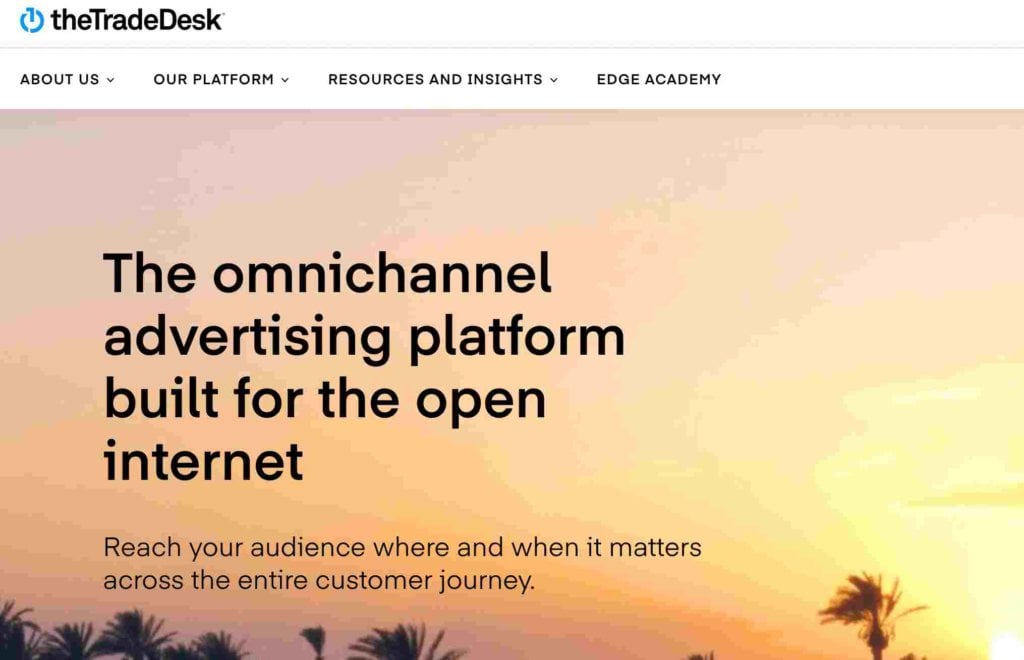
Google Display & Video 360
Display & Video 360 is a comprehensive programmatic advertising solution within the Google marketing platform, suitable for businesses of all sizes.
It includes five key modules: creatives, campaigns, audiences, inventory, and insights. The platform supports cross-channel media planning, various ad formats, audience management, and robust fraud prevention.
With numerous integrations, including Analytics 360 and YouTube, and ongoing feature updates, this platform offers powerful tools for reaching global audiences and optimizing ad campaigns.
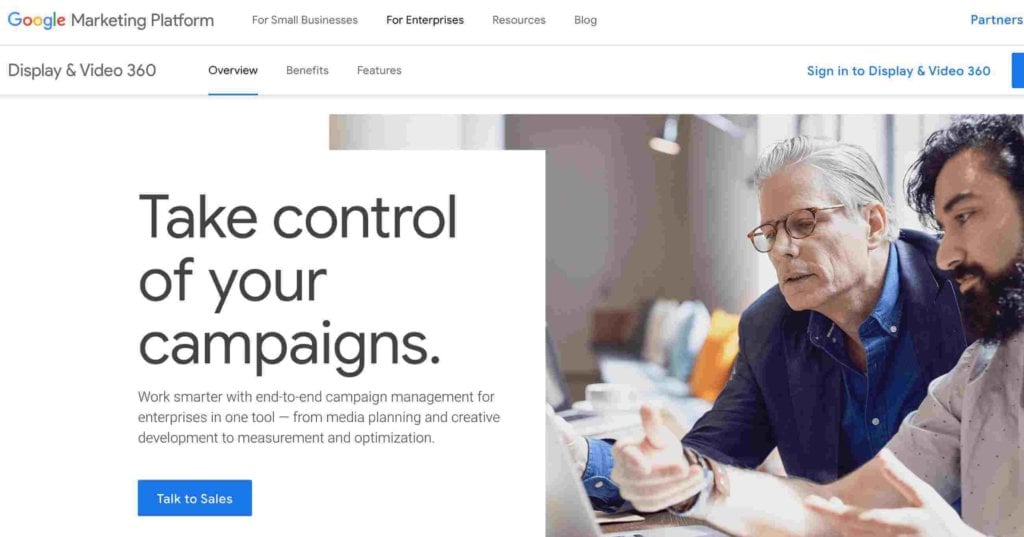
Amazon DSP
Amazon DSP is a powerful DSP that allows the purchase of display, video, and audio ads across a vast network of publishers, including Amazon-owned sites like Zappos and Audible.
It offers customizable templates for ad creation, effective analytics with Amazon-specific metrics, audience insights for market comparison, and A/B testing.
Available to both Amazon sellers and non-sellers, it provides managed and self-service options. The managed service typically requires a $50k minimum spend.
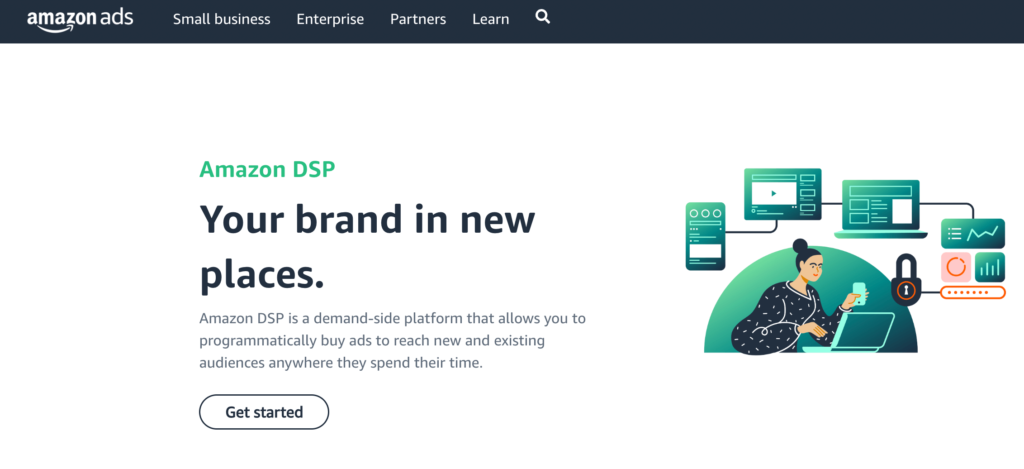
Criteo
Criteo is a leading DSP known for its retargeting capabilities. It serves over 1.2 billion ads annually across desktop, mobile, tablet, and video formats. It offers extensive omnichannel reach, delivering web, in-app, and CTV ads.
Key features include strong and precise targeting options, real-time reporting, and access to a vast network of premium publishers. Criteo supports CPC and CPM-based campaigns, optimizing ads for various devices and screens dynamically.
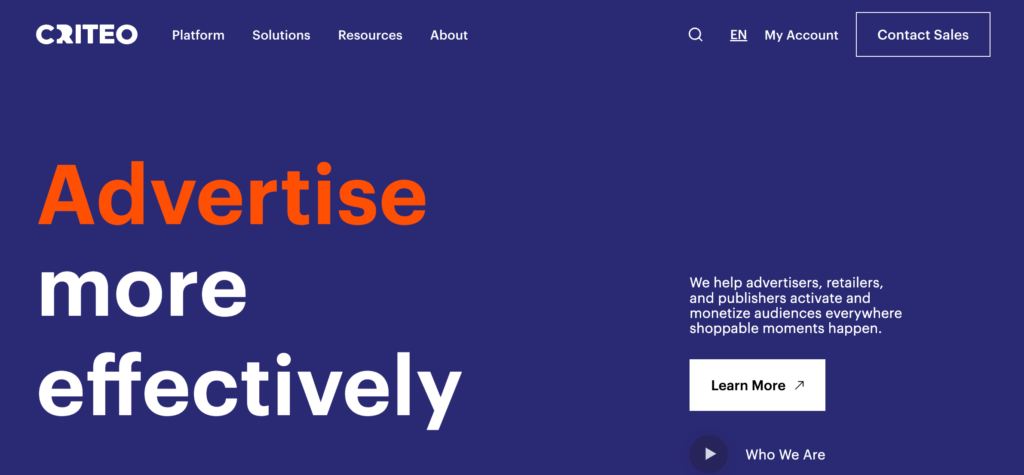
Xandr Invest (Microsoft Invest)
Note: Xandr is now part of Microsoft.
Xandr Invest, now owned by Microsoft but originally created by AT&T, is a DSP specializing in CTV and digital video ad inventory. Originally known as AppNexus, it offers extensive targeting with over 2,500 audience segments derived from high-quality first-party data.
Xandr supports various cross-channel ad formats, including display, mobile, video, in-app, OTT, and CTV, all optimized for different environments and resolutions. Its real-time attribution and comprehensive reporting system provide clear performance insights.
Additionally, Xandr ensures brand safety and fraud prevention through rigorous traffic monitoring and integration with safety providers.
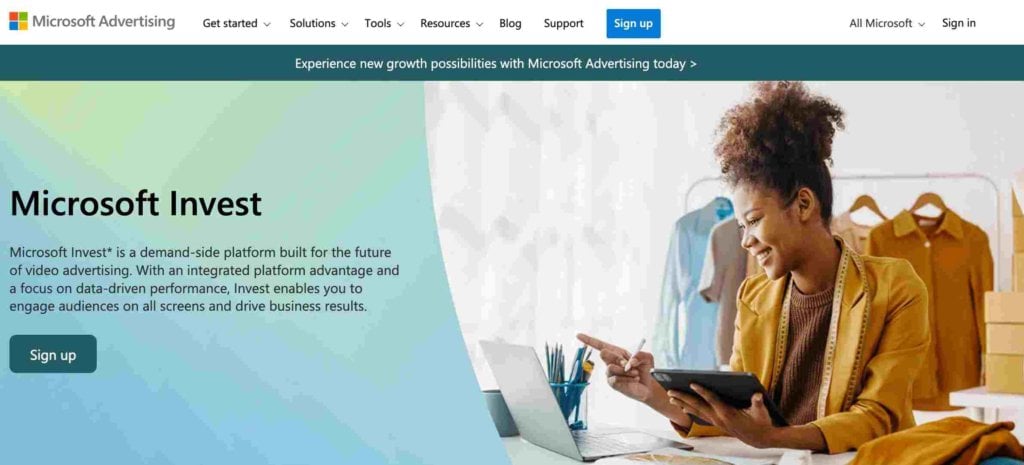
Conclusion
Demand-side platforms enable advertisers to purchase ad inventory programmatically across multiple channels and devices. They remain a critical tool for advertisers seeking to reach their target audiences effectively and drive meaningful results. With features like RTB, comprehensive audience targeting, and advanced analytics, DSPs offer a powerful solution for optimizing ad spend and maximizing campaign performance.
To sum up, DSPs drive efficient, data-driven digital advertising, empowering marketers to reach their target audiences with precision and optimize their campaigns for maximum impact.
FAQs
What distinguishes a DSP from other advertising platforms?
A DSP enables advertisers to buy ad inventory across multiple exchanges in real-time, offering advanced targeting, automated bidding, and comprehensive analytics, unlike traditional advertising platforms that may focus on direct buys or a single network.
How does a DSP ensure data privacy?
A DSP ensures data privacy by adhering to industry standards and regulations such as GDPR and CCPA, using data encryption, and implementing strict access controls and anonymization techniques.
What are the initial costs associated with using a DSP?
Depending on the provider, initial DSP costs typically include a setup fee, a minimum spend requirement, and possibly a monthly platform fee.
How can a publisher assess the effectiveness of their DSP?
A publisher can evaluate the effectiveness of their DSP by analyzing key performance metrics such as fill rate, eCPM, ad revenue, and the quality of demand sources.
Future-proofing DSP investments: what should publishers know?
Publishers should ensure their DSP supports emerging ad formats, integrates with other key ad tech tools, provides robust data analytics, and adheres to evolving privacy regulations.
Is Google Ads a DSP?
Google Ads is not a DSP, it is primarily an ad network, though Google offers a DSP called Display & Video 360 as part of its Google Marketing Platform.


